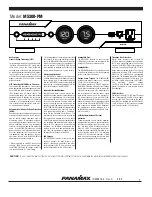
Blocking principles
The blocking signals are normally coming from the bay control function (QCBAY)
and via the IEC 61850 communication from the operator place.
The different blocking possibilities are:
•
Block/deblock of command. It is used to block command for operation of
position.
•
Blocking of function, BLOCK. If the BLOCK signal is set, it means that the
function is active, but no outputs are generated, no reporting, control commands
are rejected and functional and configuration data is visible.
The different block conditions will only affect the operation of this
function, that is, no blocking signals will be "forwarded" to other
functions. The above blocking outputs are stored in a non-volatile
memory.
Dependence on Operator place
For commands from communication protocol, such as IEC 61850-8-1 and DNP, and
through the inputs
L_SEL
,
L_OPEN
and
L_CLOSE
, the operator place is evaluated,
and only commands from enabled operator places are accepted, see Table
.
Commands through the inputs
L_SEL
,
L_OPEN
and
L_CLOSE
are always from the
local operator place. For commands through the inputs
AU_OPEN
and
AU_CLOSE
,
the operator place is not evaluated, thus also accepted when the operator place selector
is set to Faulty or Off.
Interaction with synchrocheck and synchronizing functions
The Switch controller (SCSWI) works in conjunction with the synchrocheck and the
synchronizing function (SESRSYN). It is assumed that the synchrocheck function is
continuously in operation and gives the result to SCSWI. The result from the
synchrocheck function is evaluated during the close execution. If the operator
performs an override of the synchrocheck, the evaluation of the synchrocheck state is
omitted. When there is a positive confirmation from the synchrocheck function,
SCSWI will send the close signal EXE_CL to the switch function Circuit breaker
(SXCBR).
When there is no positive confirmation from the synchrocheck function, SCSWI will
send a start signal START_SY to the synchronizing function, which will send the
closing command to SXCBR when the synchronizing conditions are fulfilled, see
Figure
. If no synchronizing function is included, the timer for supervision of the
"synchronizing in progress signal" is set to 0, which means no start of the
synchronizing function. SCSWI will then set the attribute "blocked-by-
synchrocheck" in the "cause" signal. See also the time diagram in Figure
.
Section 14
1MRK502052-UEN B
Control
720
Technical manual
Summary of Contents for Relion REG670
Page 1: ...Relion 670 series Generator protection REG670 2 0 IEC Technical manual ...
Page 2: ......
Page 44: ...38 ...
Page 58: ...52 ...
Page 80: ...74 ...
Page 106: ...100 ...
Page 482: ...476 ...
Page 548: ...542 ...
Page 570: ...564 ...
Page 600: ...594 ...
Page 608: ...602 ...
Page 630: ...624 ...
Page 862: ...856 ...
Page 1094: ...1088 ...
Page 1226: ...1220 ...
Page 1250: ...1244 ...
Page 1297: ...1291 ...









































